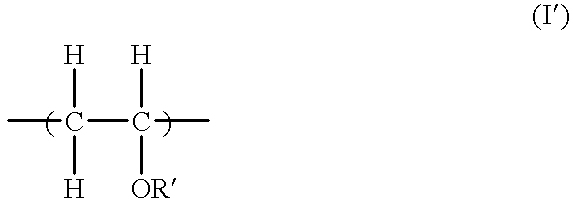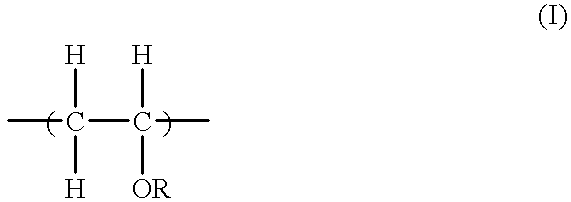Lubricating oil for compression-type refrigerators containing pentafluoroethane and a polyvinyl ether
a technology of pentafluoroethane and lubricating oil, which is applied in the direction of lubricant composition, chemistry apparatus and processes, base materials, etc., can solve the problems of insufficient lubrication, adverse effects on the life and efficiency of the apparatus, and a great extent of the apparatus li
- Summary
- Abstract
- Description
- Claims
- Application Information
AI Technical Summary
Problems solved by technology
Method used
Image
Examples
preparation example 2
Into a 1 liter glass separable flask, 148,2 g of toluene, 27.38 g (5.94.times.10.sup.-1 mol) of ethanol, 4.90 g (6.6.times.10.sup.-2 mol) of isobutanol, and 0.260 g of boron trifluoride etherate were charged. Then, a mixture of 465.83 g (6.460 mol) of ethyl vinyl ether and 71.89 g (7.18.times.10.sup.-1 mol) of isobutyl vinyl ether was added to the obtained mixture during 5 hours. Because heat is generated by the reaction, the flask was cooled in an ice water bath, and the temperature of the reaction solution was kept at 25.degree. C.
The obtained reaction solution was transferred to a 2 liter washing tank and washed with 200 ml of a 3% by weight aqueous solution of sodium hydroxide twice and then with 200 ml of distilled water three times. The solvent and light fractions were removed from the washed reaction solution under a vacuum by using a rotary evaporator to obtain 550.0 g of a crude product.
An autoclave containing a catalyst prepared in accordance with the same procedures as th...
preparation example 3
Into a 1 liter glass separable flask, 125 g of isooctane, 60.93 g (8.22.times.10.sup.-1 mol) of isobutanol, and 0.323 g of boron trifluoride etherate were charged. Then, a mixture of 307.06 g (4.258 mol) of ethyl vinyl ether and 202.01 g (2.02 mol) of isobutyl vinyl ether was added to the obtained mixture during 5 hours. Because heat is generated by the reaction, the flask was cooled in an ice water bath, and the temperature of the reaction solution was kept at 45.degree. C.
The obtained reaction solution was transferred to a 2 liter washing tank and washed with 200 ml of a 3% by weight aqueous solution of sodium hydroxide twice and then with 200 ml of distilled water three times. The solvent and light fractions were removed from the washed reaction solution under a vacuum by using a rotary evaporator to obtain 530.0 g of a crude product.
An autoclave containing a catalyst prepared in accordance with the same procedures as those conducted in Preparation Example of Catalyst 1 was opene...
preparation example 4
Into a 1 liter glass separable flask, 125 g of isooctane, 44.70 g (6.03.times.10.sup.-1 mol) of isobutanol, and 0.237 g of boron trifluoride etherate were placed. Then, a mixture of 507.38 g (7.036 mol) of ethyl vinyl ether and 17.96 g (1.79.times.10.sup.-1 mol) of isobutyl vinyl ether was added to the obtained mixture during 5 hours. Because heat is generated by the reaction, the flask was cooled in an ice water bath, and the temperature of the reaction solution was kept at 45.degree. C.
The obtained reaction solution was transferred to a 2 liter washing tank and washed with 200 ml of a 3% by weight aqueous solution of sodium hydroxide twice and then with 200 ml of distilled water three times. The solvent and light fractions were removed from the washed reaction solution under a vacuum by using a rotary evaporator to obtain 543.2 g of a crude product.
An autoclave containing a catalyst prepared in accordance with the same procedures as those conducted in Preparation Example of Cataly...
PUM
| Property | Measurement | Unit |
|---|---|---|
| temperature | aaaaa | aaaaa |
| temperature | aaaaa | aaaaa |
| temperature | aaaaa | aaaaa |
Abstract
Description
Claims
Application Information
 Login to View More
Login to View More - R&D
- Intellectual Property
- Life Sciences
- Materials
- Tech Scout
- Unparalleled Data Quality
- Higher Quality Content
- 60% Fewer Hallucinations
Browse by: Latest US Patents, China's latest patents, Technical Efficacy Thesaurus, Application Domain, Technology Topic, Popular Technical Reports.
© 2025 PatSnap. All rights reserved.Legal|Privacy policy|Modern Slavery Act Transparency Statement|Sitemap|About US| Contact US: help@patsnap.com



